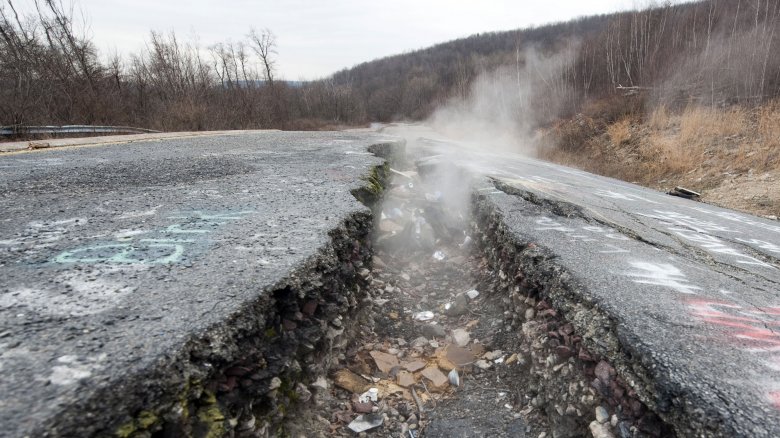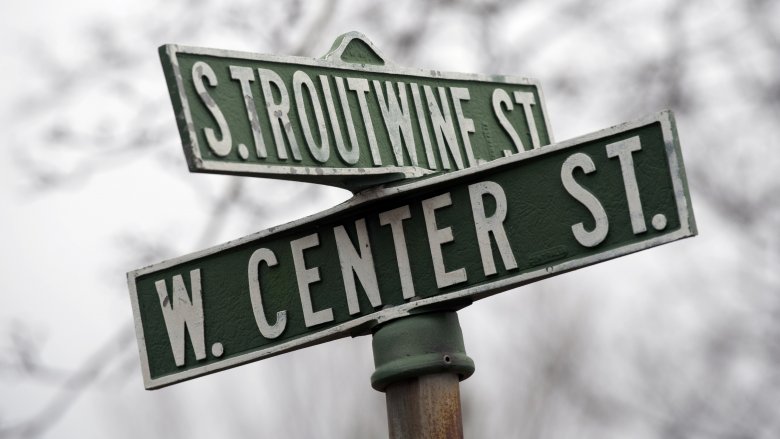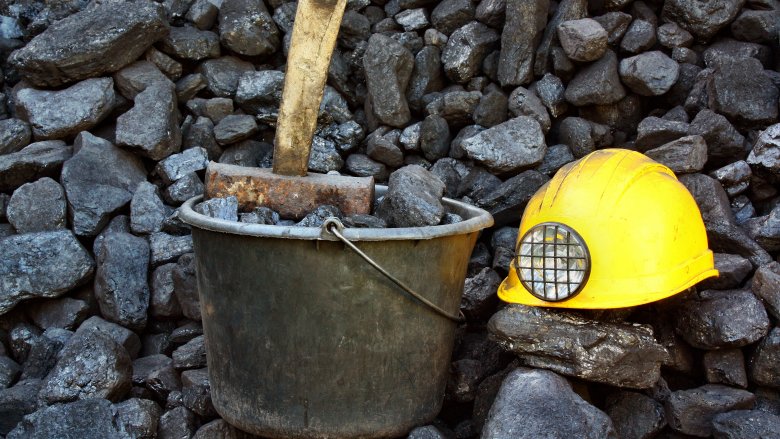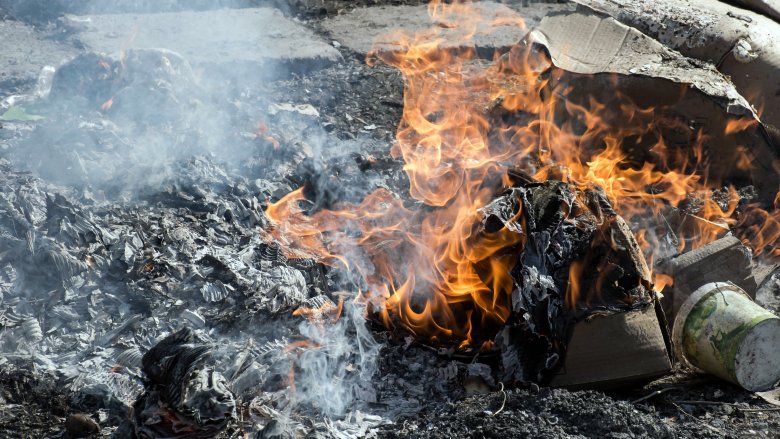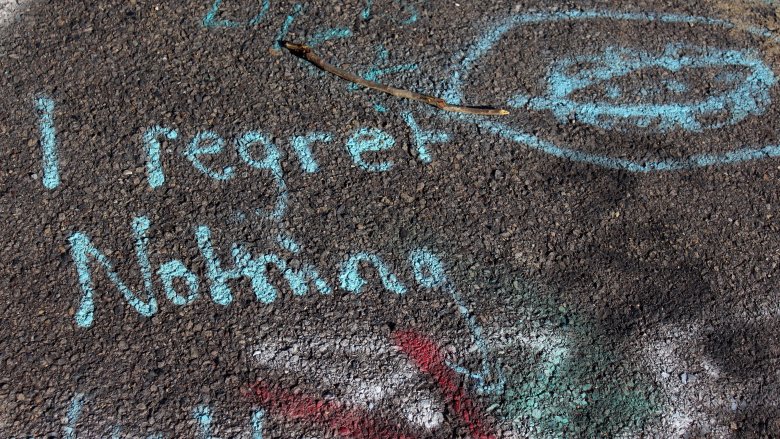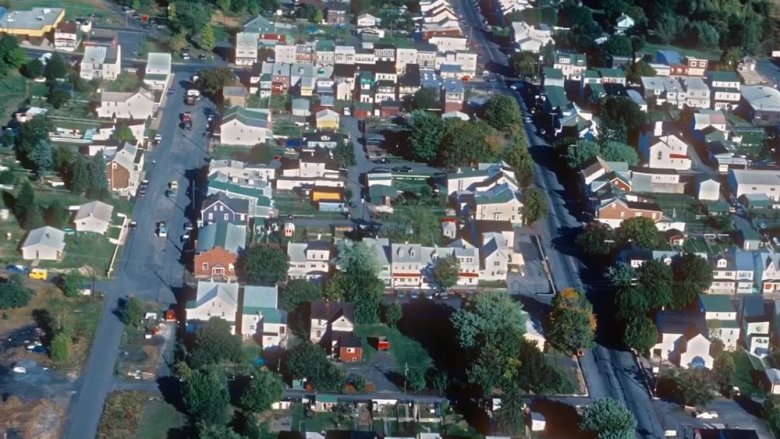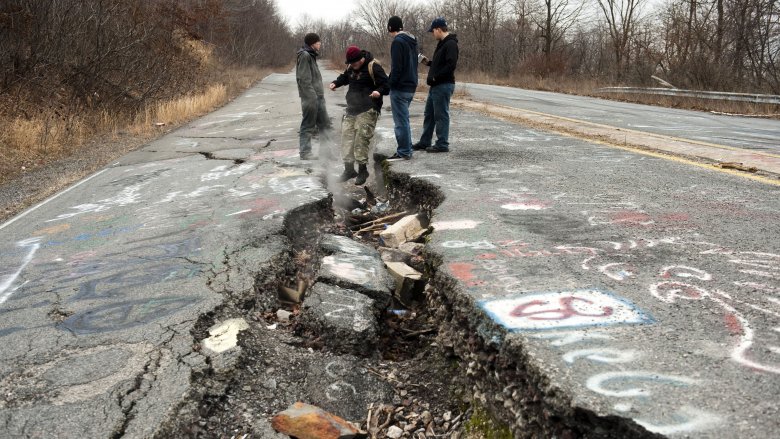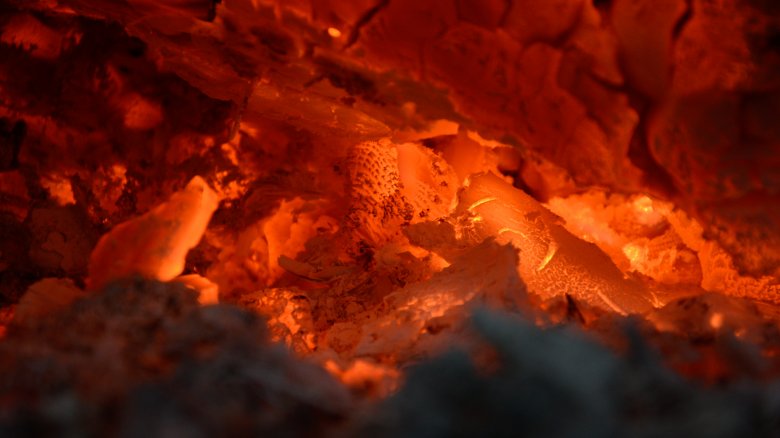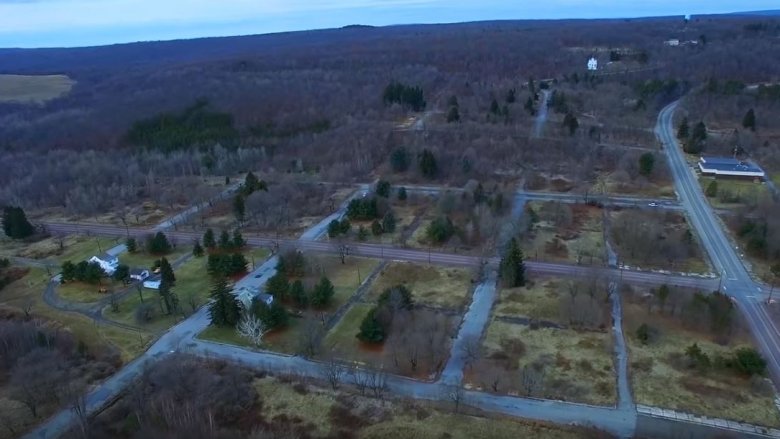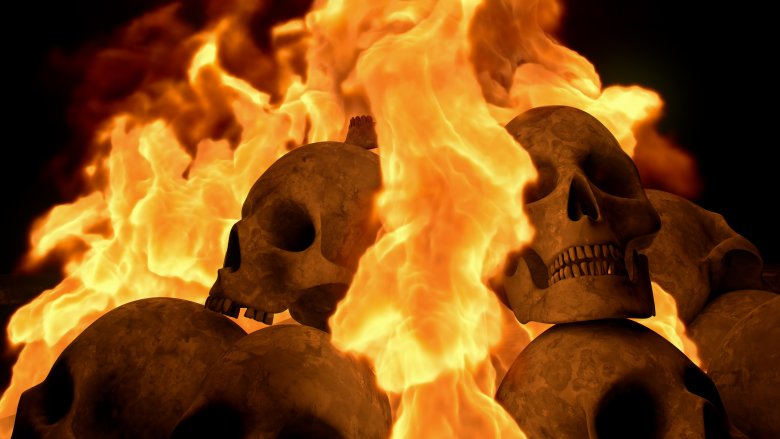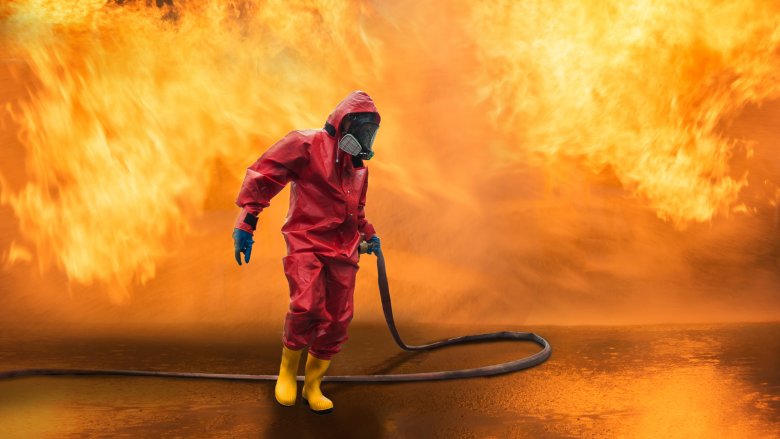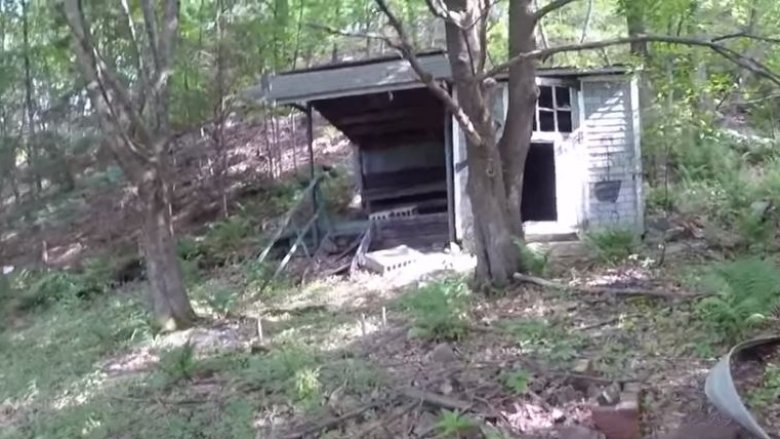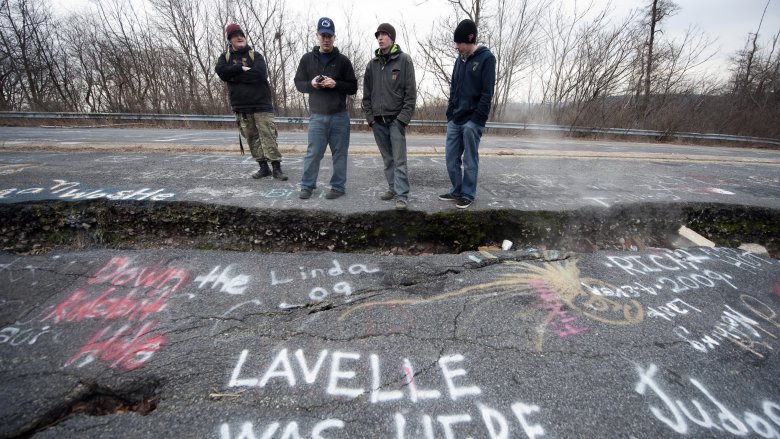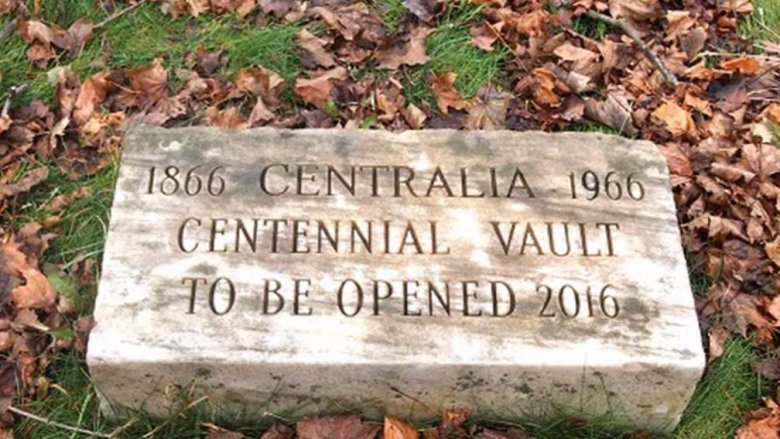Why This Fire Has Been Burning Under Centralia, PA For Over 50 Years
In today's satirical news: pigs fly, unicorns are real, and a raging inferno has been burning under Pennsylvania for over half a century.
No, wait. The last one is real, and while that crazy religious zealot at the DMV might tell you it's the gates of Hell trying to swallow all those Pennsylvanian sinners, the truth is a lot less mythological ... but no less weird. The town of Centralia was once an ordinary slice of Americana, but these days, the ghostly ruins of the so-called "real Silent Hill" sit atop an inferno that'll still be around when your grandkids turn into grandparents. Today's Centralia has no zip code, no stores, and almost no people — other than a few stubborn locals who have refused to leave — walking around its empty streets. Ever wondered what it would look like if an ordinary town became an apocalyptic wasteland? Well, here's what happened to Centralia.
The old Centralia
Before Centralia became a living horror movie, it was just an ordinary U.S. village, with the sort of textbook history you might expect. According to author David Dekok, the land was purchased for 500 pounds from local indigenous tribes in 1749, and over the next few centuries, Centralia grew to become a small hub of shops, local stories, and residential homes.
Like any town, Centralia had a few dark periods in its time. Perhaps most notable, was the sketchy stretch during the heyday of the Molly Maguires, an Irish secret society that allegedly painted the town red for nearly 30 years, according to author Deryl B. Johnson. Their supposed crime wave lasted from 1860 to 1890, with the group being suspected in "some 260 murders," including that of Centralia's founder, Alexander Rae. However, Johnson writes, "Some believe that the Mollies were guilty, while others claim that the Mollies were framed by the owners of the mines," who were afraid of the group's possible efforts to organize labor.
Scary stuff, but Centralia survived. It also weathered the Great Depression, two World Wars, and a recurring issue with trash disposal, according to History. Throughout it all, unfortunately, the Grim Reaper had Centralia's number ... and the bony one's scythe was pointed right at the town's most important industry, coal.
A once proud industry town
Centralia and coal were like two peas in an ashy pod. It was a place built on the mining industry that ended up being a place that died on the mining industry.
Though the Pennsylvania town was never a bustling metropolis — not by a long shot — it was a great place to mine coal, and that made it a fairly happy home for numerous miners and their families throughout the decades. At Centralia's peak in 1890, History says that the town had a population of almost 3,000, so basically, it was the kind of homey spot where everybody knew everybody, but not everybody was related. You might have grown up somewhere similar.
Going into the 20th century, as coal's popularity started to slide, Centralia lost many residents, and by 1962, it only had a population of about 1,400, according to Centralia PA. Despite Centralia's economic struggles, the locals still had a lot of hometown pride, so they marched forward into the future ... unaware that, on the eve of a great celebration, everything was about to go up in flames. Literally.
Centralia's rather trashy problem
Centralia had a rather large veteran population, so the annual Memorial Day celebration was a big deal. Every year, the local American Legion honored Centralia's soldiers with a color guard parade that went from cemetery to cemetery, firing shots to honor the deceased. In May of 1962, however, the town hit a rather nasty stumbling block, according to author David Dekok. The whole place smelled like stinky, rotten trash, and had rats everywhere. No good. One cause of this problem, according to History, was the fact that Centralia had "unregulated dumps" up the wazoo. The smelliest culprit, according to Ripley's Believe it or Not, turned out to be a 300-foot wide, 75-foot long monstrosity of epic proportions. In other words, vermin city.
In order to take care of the stinky odors, Centralia's city council allegedly agreed to set the giant landfill on fire. Totally illegal, and thus, not officially recorded on the council's minutes, Dekok concluded through his own research that it was this fire that unintentionally started the infamous subterranean blaze. Although Centralia's local firefighters were allegedly on site to manage what was supposed to be a routine, controlled burn, the fire ended up creeping downward faster than they expected, finding its hot new home in the intricate maze of old mining tunnels. Like a bad neighbor, it never left.
Does anyone actually know how the fire started?
To be fair, while author David Dekok's theory regarding the illegal dumpster fire causing Centralia's woes is the most widely reported explanation, it's not settled fact, and Centralia PA does point out that there are some competing ideas floating around. Allegedly, some people have argued that the trash fire was accidental — rather than being intentional — and caused by an anonymous garbageman dumping trash with "hot embers" into the landfill. Sure, blame it on the working class guy. Other critics suspect that an old mine fire might've been burning away beneath Centralia all this time, and that in 1962 it merely got "rekindled." Uh-huh.
These are nice ideas, but whereas Dekok's argument was heavily researched, these theories have no evidence to support them. Furthermore, do you notice how both theories take the blame away from Centralia's city council? If Dekok's analysis is correct, then it seems quite possible that these alternative stories are simply a way for guilty parties to shift the blame for having authorized an illicit activity (dump burning) which, well, turned out quite horrifically in the end.
Centralia moves on ... as the fire rolls underneath them
How do you treat a fire? You try to put it out, of course. As explained by author David Dekok, local firefighters poured water on the problem, day after day, but new flames kept sparking up. A drilling project proved unsuccessful. Digging a trench was fruitless. Solutions like clay, ash, and/or rocks did nothing. The problem was two-fold: for one, Centralia had a gazillion old "bootleg" mine shafts underneath it, as explained by the New York Times, giving the fire countless paths to choose from, and a lot of oxygen sources, making it impossible to seal off the flames. The second problem was, annoyingly enough, money. While People estimates that Centralia's underground fire problem could have been solved for about $50,000, the town's budget for the issue didn't cover the state and federal demand "that half of that cost come from the county." So, instead, "the fire was covered up."
Remember that $50,000 number, by the way: costly as it sounds, it's going to look quite low at the end of this story. Anyhow, as the grounds beneath Centralia reached unholy temperatures, life went on. Months passed, turned into years, and became decades. In retrospect, this sounds crazy, but it's exactly what happened.
People get hurt
According to author David Dekok, local Pennsylvanian governments formulated an ambitious two-phase plan, known as the Centralia Mine Fire Control Project to deal with the fire burning under Centralia. However, a combination of bureaucratic red tape and the public's perception of the fire being more like quirky folklore seriously hampered the project's efforts. It wasn't until 1979 — yes, a startling 15 years later — that the problem became "widely apparent", according to Slate. That's when Mayor John Coddington, upon checking the fuel levels of his gas station's underground tanks, discovered that the gasoline was boiling away at 172 degrees Fahrenheit. Oh, man.
A few years later, in 1981, Dekok writes that a preteen boy named Todd Domboksi investigated "a wisp" of smoke, when — out of nowhere — the ground suddenly ripped open beneath him. No, seriously, this happened. The boy dropped three feet down, and was sliding further, but survived thanks to his desperate grip on a miraculously well-placed ash tree root, and the help of his loyal cousin. A close call, for sure.
According to People, the Centralia apocalypse grew only more apocalyptic from there. Houses tilted like mad. Lethal carbon monoxide gases spewed into people's basements. Random holes, like the one that tried to swallow Domboski, opened up all over the woods and streets, without warning. The inferno was rising, and most people were getting scared ... but others, oddly enough, still refused to accept the reality of the situation.
The debate rages along with the fire
By that point, you'd think everyone would've hit the road. It sounds easy enough, right? Sadly, in real life, it's pretty hard to leave your home behind forever, even if the warning signs are red hot.
Following the whole "boy drops into a sinkhole" incident, People wrote in 1981 that some Centralia residents still refused to leave their homes, falling prey to ludicrous conspiracy theories about how the fire beneath them was just a villainous attempt by coal companies, energy providers, and/or the so-called "Arabs" to steal their land. Yes, really. Some people stayed merely "to spite" the scientists who were trying to rescue them, according to Cracked. Others refused to install gas detection machines, even as their neighbors were sickened by the lethal gas. Penn State University writes that the Centralia community became fractured into various circles, with a particularly fervent battle waged between the "cold-side" Centralians, who lived further away from the danger zone — and "hot-side" Centralians, who were understandably far more concerned by the fact that a portal to Hell was opening up beneath them ala Doom 3.
The mass (forced) exodus from Centralia
Question: after decades of inaction, debate, and horror stories, how was it possible for the U.S. Congress to fix a hellish fire burning beneath an American town?
Answer: They didn't. In 1982, they just booted everyone out, by approving a budget of $42 million and paying everyone to leave, according to author David Dekok, though some relocation efforts had already been underway beforehand. Hey, remember that $50,000 number? Sure sounds swell by this point in the story, right? As they always say, hindsight is 20/20.
Anyhow, the exile process was voluntary, and most people found it much easier to leave their childhood homes once Congress stuffed thousands of dollars into their faces. Then, every time a family shipped out, the property was bulldozed. As the decade progressed, Congress successfully relocated almost all of the original Centralians. In the early nineties, most of these remaining hold-outs were more forcibly relocated by Pennsylvania Governor Robert P. Casey, through a declaration of eminent domain, but a few die-hards dug their feet in ... leading to decades of legal battles. It took until 2002 for Centralia to become a true ghost town, according to Slate, as its zip code was finally erased from the books.
How the fire still burns today
It might sound crazy that, in today's world, a country as wealthy as the United States would elect to let an entire town go kaput. However, the sheer length of time that Centralia's fire problems went untreated — and the unique complexity of the situation, with that whole Pacman's maze of old mining tunnels down there — eventually made the issue too expensive to fix. Hey, spending upfront is often better than putting off the problem, and this is a great example of why.
Here's an even crazier thing, though. According to the Washington Post, it has been predicted that the Centralia fire may burn for another 250 years, thanks to the plethora of coal down there. Wow. Basically, now that the town has been (mostly) abandoned and the dirty work is done, everybody's done pumping water down there, and nobody's expecting a miracle. As geologist Steve Jones told the Smithsonian, "Putting it out is the impossible dream."
Heat-loving bacteria are the new Centralians
Even situations as certifiably insane and horrifying as this disaster can have a silver lining. For example, while the searingly hot conditions of Centralia have rendered it into an environment you wouldn't want to live in, Quanta Magazine reports that there are plenty of extremophile bacteria which consider it the perfect bachelor pad. These heat-loving microbes had lain dormant before the underground fire happened, and from a scientific perspective, that's fascinating: it illuminates the possibility that a vast reservoir of the world's biodiversity may be composed not of active life, but rather, a bunch of sleepy microbes, or "microbial seed banks," who are just waiting to jump out of bed once the next environmental catastrophe occurs. For you, a ground temperature of 900 degrees Fahrenheit is horrifying, but for them? Vacation!
So, keep this in mind, folks. Even if you die, or the human race wipes itself out with some sort of nuclear stupidity, these sorts of critters will survive. Nice thought, right?
Believe it or not, people still call Centralia home
There are still people living in Centralia. Not many — it's believed to be six or eight, at most — but they're around. These dedicated Centralians spent decades battling for their homes, according to Slate, leading to a 2013 court decision that allowed them to stay, provided that their properties went back to the government upon their deaths. So no, junior, you don't get to inherit that house sitting above a cavern of flames. Sorry.
It's hard to pinpoint why these folks became so dedicated to living in a place with no mailing addresses, no police department, and graffiti-covered streets with gashes that spew carbon monoxide ... but hey, it's what they want, and they fought for it. Nonetheless, Centralia residents interviewed by Cracked stated that smoky sinkholes are still a regular problem, since they've been known to open up in the woods and snap people's ankles, or even swallow an innocent deer whole. Yes, these are the infamous "holes" that your grandpa was so worried you might "wander into" if you weren't looking.
One building that has held up remarkably well, according to the BBC, is Centralia's Ukrainian Catholic Church, a white beacon of strength to the former Centralians who still visit. Luckily for the church, drilling has shown that the foundation was built on "solid rock [rather than coal]," so it'll probably keep standing for a long time.
Tourist hotspot and cultural touchstone
Obviously, a place as freaky as Centralia can't help but fascinate all the horror authors out there, and David Dekok writes that the ghost town influenced the comic book Carbon Knight, as well as novels by Dean Koontz, Jennifer Finney Boylan, and Lauren Wolk. Of course, the most famous fictional property inspired by Centralia is the Silent Hill game franchise, which places the player in a survival horror scenario where they must navigate around a desecrated village now overrun by a cult.
In real life, a good ghost town always pulls in the curious, so the oft-proclaimed "real Silent Hill" has become a popular tourist hub. These days, plenty of Pennsylvania visitors flock to see the smoldering remains of this lost U.S. village, as gashes spew smoke, cemeteries get more overgrown, and all signs of human society become increasingly rusted out.
Visitors should be careful, however. For one, remember those sinkholes! Two, don't breathe the gases. Three, Uncovering Pennsylvania cautions guests to respect the privacy of those who still call Centralia home, by not trespassing on their property. So if you do visit, leave the locals alone, and definitely don't break into their houses. They have a right to their privacy.
Centralia's time capsule is opened ... early
By 1966, Centralia's underground fire had already been burning for a few years, but nobody had any idea just how bad the problem would get. Seriously, who could ever predict a nightmare like that? So, according to the Pocono Record, the Centralia American Legion celebrated the town's centennial by burying a time capsule near the St. Ignatius Cemetery. The goal was to open it fifty years later, in 2016, to commemorate Centralia's 150th anniversary.
Well, great news: the time capsule was uninjured by the fire! Not so great? In May of 2014 — two years before the capsule was set to be opened — some selfish vandals tampered with the capsule. These actions forced an early reveal party, just to make sure nothing had been stolen. While many of the items had gone moldy, others were still well-preserved, and these relics were given back to the families who donated them all those years ago.
In the end, the fate of the time capsule is, perhaps, a perfect embodiment of this town's unfortunate legacy. Centralia may have been wiped away from the present, vandalized, and desecrated, but the history book never forgets ... and while the old Centralia may be gone, its bizarre fate will always be remembered.
